As customers begin to really accept and utilize a Microsoft Dynamics CRM system, many clients might find themselves in a situation where they’d like to use posts, notes and the knowledgebase to stay informed not only of their products but about customer service methodologies, FAQs, SOPs and company templates and internal organizational documents.
However, there are limitations: Notes can contain document attachments up to 5MB and while this can be increased for on-premises installations to 9MB. Sales literature and Knowledge Base Articles have size and collaboration limitations. And, most importantly there is no way to present some of these documents to customers in a “self-service” fashion. In such cases where you may find yourself yearning for an easy solution, one option is to integrate with SharePoint. SharePoint is very extensible and can actually accentuate your Dynamics CRM investment. One of the other benefits for SharePoint for Dynamics CRM online clients is that Dynamics CRM charges you per GB/month for each GB of storage where you exceed your allotted limit. Also, each Dynamics CRM online instance has a cap of how big the database can be. Many times, clients already have access to it through their subscriptions in Office 365.
As a national partner with the Gold Customer Relationship Management (CRM) competency in the Microsoft Partner Network, we get a lot of questions about integrating SharePoint with Microsoft Dynamics CRM. If you are already using Dynamics CRM Online, it is very easy to leverage this investment with an Office 365 subscription. To this end, several of the Office 365 licensing options come with SharePoint Online as an included add-on.
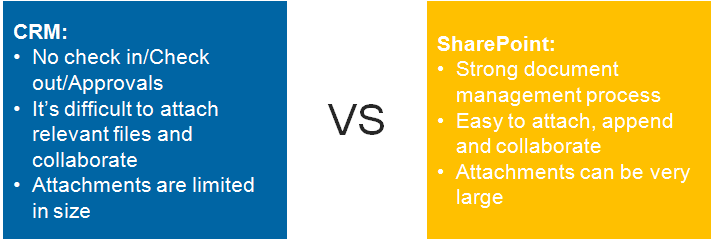
These complementary feature sets suggest using SharePoint for the collaborative document creation and management tasks, and as the repository for a document’s version history.
Dynamics CRM Entities that can easily take advantage of SharePoint integration include:
- Products: View and add information about existing products, licensing and kits that may be part of an Opportunity or service request. For example, the customer might already possess a bike that has a broken chain. You see that it is an older bike, but that new bikes are available through the documents. You reference and send information about the new bike and upon interest, create a new opportunity – all while helping out your customer.
- Documents: Add a document location associated with the Opportunity record by specifying a URL of an existing SharePoint folder.
- Quotes: reference and specify price list specified via SharePoint and have external parties modify and append.
- Sales Literature: provide better information and increased business intelligence into the products, service and customer service philosophy’s and business processes of your organization. Sales literature can be associated with products, competitors and marketing campaigns. Think spec sheets, marketing flyers and FAQs.
- Customer Service: you can use SharePoint to lay out external facing documents as a first line of customer service.
- Marketing Campaigns: you can designate SharePoint as a one stop shop for special offers, targeted products
Server-based Dynamics CRM and SharePoint integration is a new feature introduced in the Spring 14 release for Dynamics CRM 2013. In this blog, I’ll discuss the integration between Dynamics CRM Online and SharePoint Online with a quick demo of what the new interaction brings you.
It is helpful to offer easy to access articles to provide quick and easy to access information for professionals to be informed about the latest and greatest products and services your company may offer. Additionally, a client-ready published version of a document might be attached to Microsoft Dynamics CRM in order to take advantage of Microsoft Dynamics CRM’s more highly structured data and its built-in ability to attach that document to customer activities such as emails, phone calls or tasks.

Once enabled, you can access relevant documents for accounts without the constraints placed on notes. Click on the documents pane on the Sales ribbon, then click documents.

You can empower your employees with account centric data that anyone within an organization can add if they have the correct permissions. For example, the finance business unit within an organization could add the company’s financials to the entity’s associated document library within the context of their SharePoint intranet site. Without needing to exit CRM and go to SharePoint and vice versa, that data becomes more collaborative and an “enabler” instead of simply on someone’s desktop or scattered file systems. In the image below, we see that the customer’s credit history could easily be leveraged, for example.
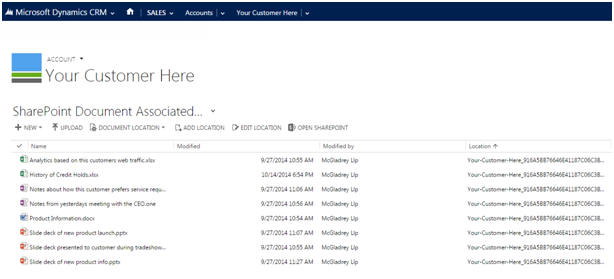
You can take this context of collaboration even further however. Take a routine service request, for example.

The document library is available on cases as well. An area where this can help a lot is for products. You don’t necessarily need product engineers and developers inside your Dynamics CRM system. However, an organization that has a strong collaboration strategy can leverage SharePoint and Dynamics CRM to provide a better experience to the customer. To do this, the product engineer can simply go to the SharePoint team site:
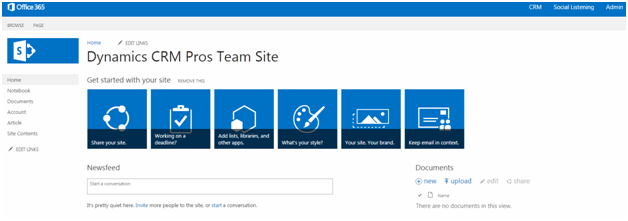
They can then simply attach a relevant document:
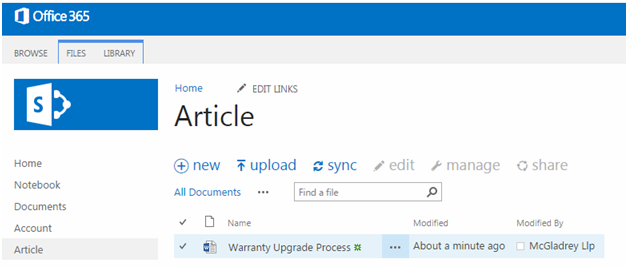
Believe it or not, this document is now available for collaboration and reference, in just these few steps:
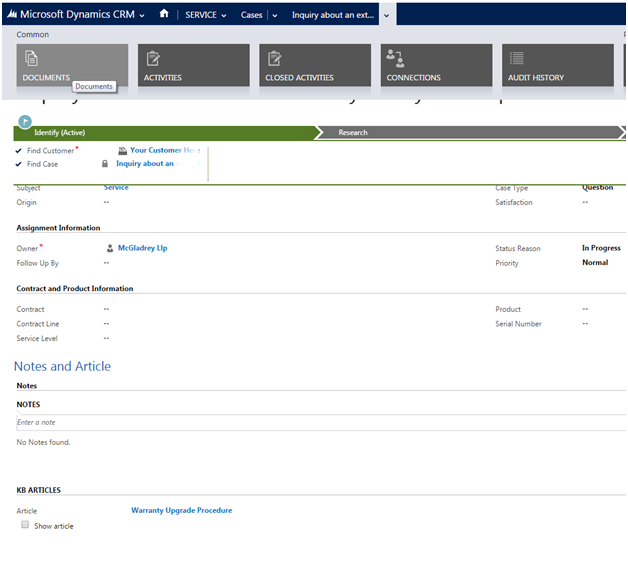
As you can see, this is a rather handy functionality.
One of the perks of a smart SharePoint investment is that there are immense, out of the box customization options available to you. Whereas before, we leveraged internal file sharing, we can actually create a full blown website out of the box and use the document library to push documents from Dynamics CRM to a public domain. The last, lesser known feature about SharePoint is that you can actually create an externally facing site and push documents from Dynamics CRM to this site – all out of the box.
This can be very useful for customer portal situations – scenarios where you’d like to give customers externally facing documents such as product information and answer FAQs. Alternatively, this can also be leveraged to as a front line customer service strategy. Let’s take a deeper dive.
First, we’ll create a new sales literature document and then save it. To demo this functionality, I’ve created faux product sheet.

Now we’ll leverage the document library to push this to SharePoint:

Note that you’ll have to opt to enable the document to be pushed to SharePoint.
You can customize the website to deliver specialized content so that when a visitor navigates to your site and then clicks the tab, New Product Releases, they can read specific documents within a folder you’ve specified, then prepare a specialized view for them.

Once you’ve added a list of relevant documents, use views and web parts to achieve your desired results on your externally facing web page. The pictures below give a sample into the very easy to customize, user experience.
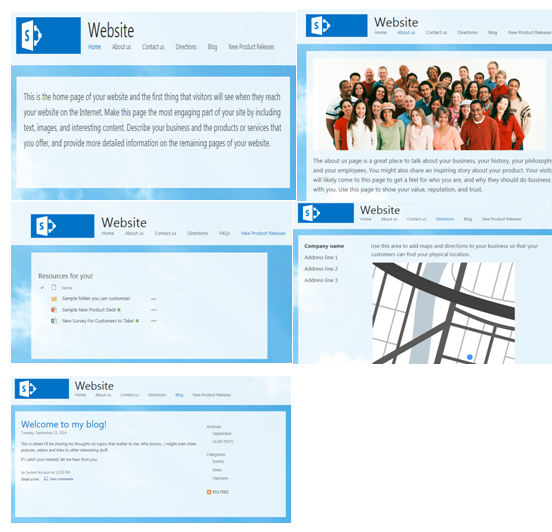
As you can see from the images above, SharePoint can help you create a nice portal for you, your staff, your business partners and importantly, your customers. You can easily extend your Dynamics CRM system to cater to customers and offer them resources and information as you see fit. In the below example, we are presenting select documents from the Sales Literature capability in Dynamics CRM.

There are many reasons that a company might decide to extend their Dynamics CRM investment with SharePoint. Consider the increased collaboration and document management tools and how these could be leveraged to get a better ROI on your enterprise software. Finally, consider the power of Dynamics CRM and the ability of your Dynamics CRM users to utilize SharePoint to increase their efficiency and finally, reach customers with relevant information.
If you are looking for more information on integrating Dynamics CRM with SharePoint, contact our professionals today at crm@mcgladrey.com or call us at 855.437.7202. We are uniquely positioned in the market with specialists in technology and management consulting practice offering Dynamics CRM and SharePoint services.
By: Charles Webb – Colorado Microsoft Dynamics CRM partner

 RSMUS.com
RSMUS.com